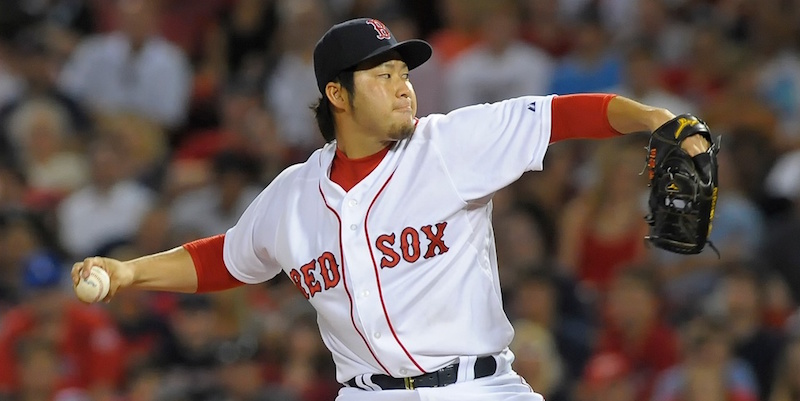Welcome to BP Boston’s Roster Recap series! Over the next four months, we’ll be breaking down every player on Boston’s 40-man roster and many of their top prospects in order to provide a comprehensive overview of the Red Sox roster’s strengths and weaknesses, as well as what we can expect moving forward. There’s no better time than the offseason to review the best (there was some best!) and worst (there was a lot of worst!) of the past year in red and navy. You can see previous editions of Roster Recap here.
In a theme that may be common in these Roster Recaps, 2015 was Junichi Tazawa’s worst season since establishing himself in the majors in 2012. Over the two seasons prior to 2015, Tazawa was ridden hard by the team, appearing in 71 games apiece plus every game but two over the 2013 postseason run to add on 13 more appearances that year. That heavy workload looks to have taken its toll last season, as it was a tale of two halves for the righty setup man.
On June 11, Tazawa lowered his ERA to 1.33 and opponents were batting .179 against. In his 32 appearances after that date, he posted a 6.54 ERA and allowed hitters to bat a whopping .350 against him. The full collapse came in August, when he put together the worst month of his career. This period also came at a time when Koji Uehara was placed on the disabled list, casting Tazawa into a closer’s role that he has not had success in throughout his career. He battled various minor ailments throughout the season, including one to the hip and groin area in late August, before finally being shut down on September 15 due to “workload concerns.”
What Went Right in 2015
Prior to his five-run, no-outs performance on June 12, just about everything was going right for Tazawa. With very little else working for Boston’s bullpen, this put a heavy burden on Taz, who had also been heavily taxed in the two previous seasons. In April, Tazawa appeared in exactly half of the team’s games (an 81-appearance pace over a full season), giving up just two earned runs and walking one while striking more than a batter per inning. That type of success—and workload—continued into May for the setup man, as he appeared in 13 of the team’s 29 games, allowing another two earned runs on the month. Although it is a small sample size from which to draw conclusions, his strikeout rate and walk rate were both worse than in April and than his career norms, which perhaps hinted at the oncoming decline.
Tazawa continued on with his dominance for his first five appearances in June, allowing just one hit and no runs in that time. Excluding that one five-run (four earned) appearance on June 12, the righty was actually solid through July, posting a 2.50 ERA over 16 games in that month and a half. His strikeout and walk rates also held strong, but his .278 batting average against over that time showed that the wear was beginning to set in, before an all-around dreadful August. Overall, Tazawa was mostly his dominant self before intermittent stumbles in June and July. Then, he completely fell off the cliff in August. The lack of other viable bullpen options led to his overuse last season, and combined with heavy workloads the two seasons prior, we arrive at what went wrong in 2015.
What Went Wrong in 2015
The second half of the season and particularly a horrific August that led to his shutdown marred what was shaping up to be another strong season from the team’s primary setup man. Tazawa appeared in half the team’s games in April and stayed close to that pace in May before slowing down only modestly. Up until he was shut down in early September, the team rode him hard despite the fall off, mostly because they had few other serviceable options out of the bullpen.
This rough period coincided with Koji Uehara being placed on the DL on August 10, giving Tazawa the opportunity to test his mettle in the ninth. However, in that month alone, he blew four save opportunities and allowed 10 earned runs in 11 total appearances. He did collect three saves in August but he was inconsistent, alternating between scoreless and blowup innings, but the three total strikeouts demonstrate just how much sharpness his stuff lacked during that time. In save situations last season, Tazawa posted a 7.11 ERA and a 1.74 WHIP versus 1.89 and 1.02, respectively, in non-save situations. Of course, his BABIP was over 100 points higher in save situations at .417, so bad luck was a factor, and he was clearly tiring at the time regardless of role. But his career number as a closer are not much better, with a 4.52 ERA and 1.30 WHIP when called on to close out the game. Lucky for him, the Red Sox acquired Craig Kimbrel this offseason, lowering any chances Tazawa will be called on to fill that role next season.
Outlook for 2016
Boston invested a lot of resources in acquiring Kimbrel, and he will immediately assume the role of closer, pushing Uehara back into a setup role. The plan is for Tazawa to share this role with him, which will hopefully help to limit both of their usages. Although this may seem like a demotion for Tazawa and Uehara, it could benefit both by allowing them to sustain the dominance they’ve shown in recent years when not injured or overtaxed. If all three can stay healthy and Tazawa can regain his dominance in a more comfortable role, the potential is there to form the most fearsome bullpen trio in the league.
Photo by Bob DeChiara/USA Today Sports Images
